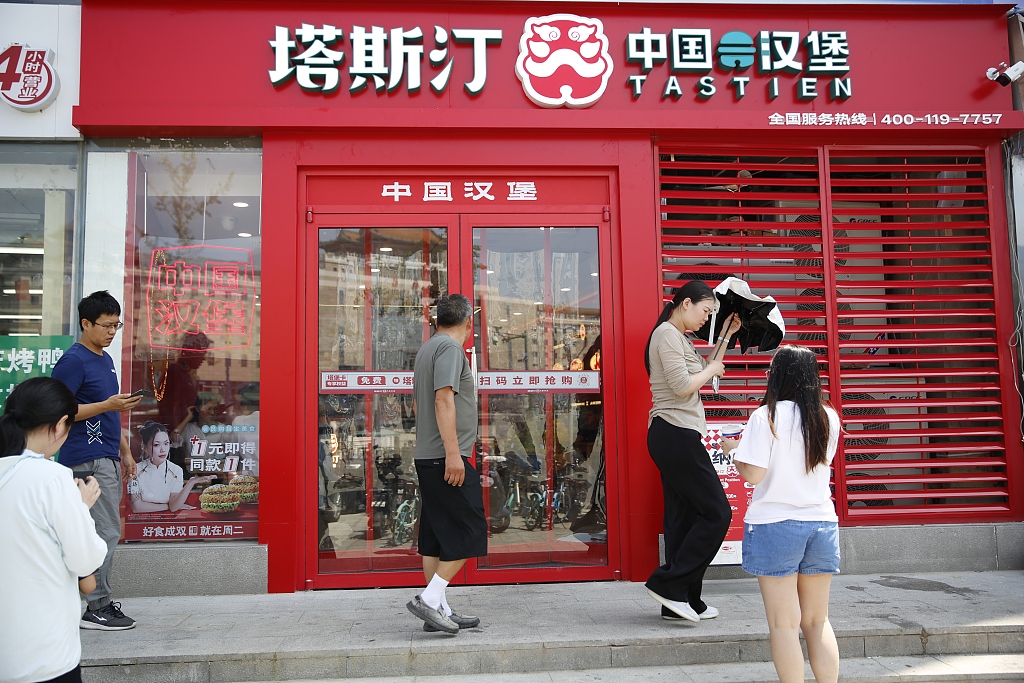In the heart of Beijing’s bustling shopping district, where luxury brands and global icons once reigned supreme, a new phenomenon is taking center stage: homegrown Chinese brands are not just making waves—they’re setting the course. Welcome to a new era in China’s consumer market, where the rise of local contenders is reshaping the landscape and challenging the dominance of American giants. This is not just a story of competition; it’s a tale of how local taste, culture, and innovation are redefining success on a global scale.
The New Face of Fast Food: Tastien’s Chinese Flavor
Imagine walking into a restaurant that looks like an American fast-food joint but proudly boasts that its burgers are made in China. This is Tastien, China’s ambitious answer to McDonald’s. At first glance, it might seem like just another fast-food restaurant with the usual offerings: burgers, fries, and drinks. But a closer look reveals a deep infusion of Chinese culture and pride. With a menu designed for the Chinese palate and decor inspired by traditional Imperial China, Tastien is more than just a meal—it’s a statement.

Tastien exemplifies a growing trend where Chinese brands are blending Western concepts with local flavors, creating products that resonate more deeply with domestic consumers. This fusion of the familiar and the cultural is giving these brands a competitive edge, showing that understanding local preferences can be as crucial as global strategies.
Apple’s Struggles: From Dominance to Decline
Once the undisputed king of the smartphone world, Apple is facing significant challenges in China. In the first quarter of 2024, Apple’s smartphone sales plummeted by 19%, while its Chinese rival, Huawei Technologies, saw a staggering 70% increase in sales. Apple’s revenue in China fell by 8% to $16.4 billion, highlighting a shift in consumer preference and a growing local competition that cannot be ignored.
This downturn is not an isolated incident. Estee Lauder and Walmart, two other American giants, have also faced setbacks in the Chinese market. Estee Lauder is bracing for a decline in sales, while Walmart has shut down over a hundred stores in the past five years. The once-promising Chinese market is proving to be a more complex and competitive landscape than many American companies anticipated.
The Rise of Anta: A National Pride Movement
In the realm of sportswear, Nike’s long-standing dominance is being challenged by Anta, a Chinese brand that has cleverly tapped into nationalistic sentiments. Anta’s success can be attributed to its alignment with Chinese pride and cultural identity. By sponsoring the Chinese Olympic team and incorporating traditional Chinese elements into its designs, Anta has won the hearts of younger Chinese consumers who are increasingly drawn to brands that reflect their own cultural values.
Anta’s bold logos and patriotic color schemes are resonating with a new generation that no longer sees Western brands as the ultimate symbol of status and quality. Instead, they are finding pride and satisfaction in supporting homegrown brands that celebrate Chinese heritage.
Luckin Coffee vs. Starbucks: The Battle for Coffee Supremacy
The coffee culture in China, once dominated by Starbucks, is undergoing a dramatic shift. Luckin Coffee, a local competitor, has not only challenged Starbucks but has also surpassed it in sales and store numbers. By the end of 2023, Luckin Coffee had more locations than Starbucks, boasting nearly 19,000 stores compared to Starbucks’ approximately 7,000.
Luckin Coffee’s success is rooted in its aggressive pricing strategy and operational efficiency. With prices often up to 50% lower than Starbucks, Luckin has attracted a large customer base looking for quality coffee at a more affordable price. This pricing strategy has sparked a price war, forcing Starbucks to reconsider its position in the market.
Starbucks, despite its commitment to a premium brand experience, has seen its sales drop by 8% in the first quarter of 2024. The company’s decision not to cut prices has contributed to its declining market share, and its recent attempt to expand rapidly across China has not been enough to stem the tide of Luckin Coffee’s rapid growth.
The Changing Landscape: American Brands’ New Reality
The rise of local Chinese brands is not just a trend; it represents a fundamental shift in consumer behavior and market dynamics. American brands that once saw China as a goldmine are now facing stiff competition from homegrown companies that are better attuned to local tastes and cultural nuances. This shift is forcing American brands to adapt quickly or risk losing their foothold in one of the world’s largest consumer markets.
For companies like Nike, Apple, and Starbucks, the challenge lies in balancing their global brand identity with the need to cater to local preferences. As Chinese brands continue to innovate and expand, the market will likely see further disruptions, reshaping the competitive landscape in ways that were previously unimaginable.
Conclusion: A New Era of Consumerism
The rise of Chinese brands like Tastien, Anta, and Luckin Coffee signals the dawn of a new era in consumerism. As local companies increasingly capture market share from their American counterparts, they are not just changing the market—they are redefining what it means to be successful in the world’s largest consumer market.
For American brands, the message is clear: understanding and integrating into local cultures is not just an option but a necessity for survival. The future will likely see even more dramatic shifts as local competitors continue to innovate and resonate with consumers in ways that traditional global brands are struggling to match.
In this new landscape, the question is not just whether a product is American or Chinese, but whether it can meet the evolving needs and desires of the modern consumer. As the competition intensifies, one thing remains certain: the story of how brands navigate this shift will be one of the defining narratives of our time.
Also Read: The Untold Story of the World’s Most Luxurious Car Brand
To read more content like this, subscribe to our newsletter
Go to the full page to view and submit the form.


